I offer this reference guide to Chinese coins with the hope of promoting greater understanding and appreciation these coins but please note THIS IS NOT A LIST OF COINS OFFERED FOR SALE.
Images represent the types and may be larger or smaller than the actual coins.
MEDIEVAL CHINESE COINS
THE SOUTHERN SUNG DYNASTY
Images on this site (more coming soon) represent types,
but bear no relationship to actual size.
The Northern and Southern Sung Dynasties are really two parts of one dynasty. The division between then is traditionally placed where the Capital was moved from K'ai-feng Fu to Lin-an (modern Hangchou) following the lose of the Northern territories to Mongol invaders. Kao Tsung, first Emperor of Southern Sung, actually ruled from the Northern capital of K'ai-feng Fu for his first two years and could also be considered the last Emperor of Northern Sung.
The Southern Sung coinage is very complex and I am still in the process of researching this portion of our reference guide. I have been experimenting with formats to presenting the information, and have not yet settled on single style, and may have to use different ones for different parts of the series. It will not be possible to list all the types, as there are too many variation in metal (copper and iron), numerous possible mint, and many coins have dates on them. I plan to build tables that allow you to identify what is on the coin, but not list all variations. I will all including a number of working theories and observations and hope they will make sense out of the complex series.
Please remember that this part of our site is still in a very rough form and is far from complete. There will undoubtedly be a number of errors that will eventually be corrected.
AVERAGE WEIGHTS
We have decided to put a chart of the denominations, sizes and weights under each reign title. When the listing is complete the larger table of this information will be eliminated from the site. It this formate proves effective, will will incorporate the it into other parts of the site. Each of these tables has a heading for "#" at the end. This refers to the number of specimens used to determine the average weight.
DENOMINATIONS
The bronze denominations used during this dynasty are similar to those used during the Northern Sung dynasty with the additions that there are some non-feduciary 5 and 10 cash issues, as well as one issue of feduciary 100 cash.
A minor difference occurs in the bronze 1 cash in that, while the Northern Sung bronze 1 cash are generally about 24 mm throughout the dynasty, the Southern Sung issues vary between 22 and 25 mm, although there is usually a consistent size within any one reign title and thought, no matter what size, the average weights seem to have remained fairly consistent with an intended weight standard somewhere just over 3 grams.
The iron denominations are very different than those used during the Northern Sung. They are still all feduciary issues, but there seems to have been more acceptance of them as a regular part of the currency although we still have some questions about this. Iron was only issued prolifically during the middle years of the dynasty with no iron issues during the last few reign titles, and there were regular issues of 1 and 2 cash, as well as fairly regular issues of 3 and 5 cash. As many of these issues have survived in fairly large numbers, we have to assume that they were not recalled and melted for scrap metal as the Northern sung issues above 1 cash seem to have been (and are thus much rarer).
Dates
Many Southern Sung coins have regnal year marks on the reverse, indicating how many years into the reign title the coin was minted. When present one can calculate the exact year of issue. The date marks we have so far imaged are below, and we will be adding more as they become available.
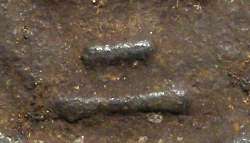 | YEAR 2 |
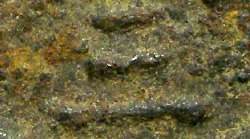 | YEAR 3 |
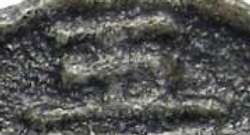 | YEAR 5 |
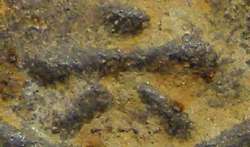 | YEAR 6 |
MINTS
Many Southern Sung coins, in particular the iron coins, have mint marks on the reverse. We are just beginning to build this section, and will be adding additional mints as images of the mint marks become available.
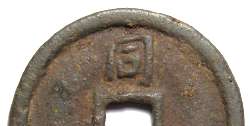 | T'UNGRefers to T'ung-an district in Fuken. |
| image not available | CH'UNRefers to Ch'i-ch'un in Szechuan. |
| image not available | HANRefers to the Han-yang in Hupei. |
BRONZE & IRON WITH REVERSE MARKS OTHER THAN DATES
(note that this list is currently far from complete)
| Reign Title | Date | Bronze | Iron |
|---|---|---|---|
| CHIEN-YEN | 1127-1130 | blank CHUAN |
blank |
| SHAO-HSING | 1131-1162 | blank crescent crescent & dots |
LI |
| LUNG-HSING | 1163-1164 | blank | blank |
| CH'IEN-TAO | 1165-1173 | blank crescent & dot CHENG |
CHIUNG T'UNG |
| SHUN-HSI | 1174-1189 | blank T'UNG CH'UAN |
crescent & 2 dots LI CHIUNG |
| SHAO-HSI | 1190-1194 | crescent & 2 dots | |
| CH'ING-YUAN | 1195-1200 | blank* | crescent & 2 dots |
| CHIA-T'AI | 1201-1204 | blank ** | |
| K'AI-HSI | 1205-1207 | blank | |
| CHIA-TING | 1208-1224 | Ch'un/value 5 | blank crescent & 2 dots TING/crescent & 2 dots CH'UAN/value 5 LI/value 5 HUI/value 5 value 5 value 10 |
| PAO-CH'ING (using Ta-sung) |
1225-1227 | blank | |
| SHAO-TING | 1228-1233 | ||
| TUAN-P'ING | 1234-1236 | blank** LI/value 10** |
blank CHIUNG/value 5 TING-WU/value 5 HUI/value5/SHI-SHANG |
| CHIA-HSI | 1237-1240 | blank ** blank * |
|
| SHUN-YU | 1241-1252 | value 100 | |
| PAO-YU (as Huang-sung) |
1253-1258 | ||
| K'AI-CHING | 1259 | ||
| CHING-TING | 1260-1264 | ||
| HSIEN-SHUN | 1265-1274 |
* - for some types, blank reverses seem to indicate year one.
** - an unusual large coin, not part of the regular series.
COIN WITH REVERSE NUMBERS (USUALLY DATES)
(note that this list is currently far from complete)
| Reign Title | Date | Metal | Mint | Year Marks Seen |
|---|---|---|---|---|
| CHIEN-YEN | 1127-1130 | bronze | blank | none |
| SHAO-HSING | 1131-1162 | bronze | blank | none |
| LUNG-HSING | 1163-1164 | bronze | blank | none |
| CH'IEN-TAO | 1165-1173 | bronze | blank | none |
| SHUN-HSI | 1174-1189 | bronze | blank | 7,8,9,10,11,12,13,14,15,16 |
| iron | Ch'un | 9,11,13,14,15,16 | ||
| iron | T'ung | 14,15 | ||
| SHAO-HSI | 1190-1194 | bronze | blank | 1,2,3,4,5 |
| iron | Ch'un | 3,4,5 | ||
| iron | T'ung | 1,4,5 | ||
| iron | Han | 1,2,3,4,5 | ||
| CH'ING-YUAN | 1195-1200 | bronze | blank | 1,2,3,4,5,6 |
| iron | Ch'un | 1,2,3,4,6 | ||
| iron | T'ung | 1,2,3,4,5,6 | ||
| iron | Han | 1,2,3,4,6 | ||
| iron | CHUAN | 5, 6-3, 7-3, 9, 6/73 | ||
| iron | crescent & 2 dots |
1-5, 2-5, 3-5, 4-5 | ||
| CHIA-T'AI | 1201-1204 | bronze | blank | 1,2,3,4 |
| iron | Ch'un | 1,2 | ||
| iron | T'ung | 2,3 | ||
| iron | Han | 1,2,3 | ||
| iron | Li | 96 (probably not a date) | ||
| iron | CHUAN | 1/83, 2/93, 3/40 | ||
| K'AI-HSI | 1205-1207 | bronze | blank | 1,2,3 |
| iron | T'ung | 1,2,3 | ||
| iron | Ch'un | 1,2,3 | ||
| iron | Han | 1,2,3 | ||
| iron | Li | 10-6 (or 16) (not a date) | ||
| iron | CHUAN | 3/24 | ||
| CHIA-TING | 1208-1224 | bronze | blank | 1,2,3,4,5,6,7,8,9,10,11,12,13,14 |
| iron | blank | 3 above & below, 3 above, | ||
| iron | blank | 2 (an unusual type) | ||
| iron | Li-chou | 1 | ||
| iron | Li | 3 | ||
| iron | T'ung | 1 | ||
| iron | Ch'un | 1,2,3,4,5,6,7,8,9,10,11,12 | ||
| iron | Han | 1,2,3,4,5,6,7,8,9,10,11,12,13 | ||
| iron | Ting | 2 | ||
| iron | various | complex unusual series S-934-958 not part of the regular series. |
||
| CHIA-TING as Shao-hsing |
1208 | iron | Li | 5 (probably denon. mark) |
| iron | blank | 5 (probably denon. mark) | ||
| PAO-CH'ING (using Ta-sung) |
1225-1227 | bronze | blank | 1,2,3 |
| iron | Ch'uan | 3 | ||
| SHAO-TING | 1228-1233 | bronze | blank | 1,2,3,4,5,6 |
| iron | Ch'un | 3 | ||
| TUAN-P'ING | 1234-1236 | bronze | blank | 1 |
| CHIA-HSI | 1237-1240 | bronze | blank | 1,2,3,4 |
| SHUN-YU | 1241-1252 | bronze | blank | 1,2,3,4,5,6,7,8,9,10,11 |
| PAO-YU (as Huang-sung) |
1253-1258 | bronze | blank | 1,2,3,4,5,6 |
| K'AI-CHING | 1259 | bronze | blank | 1 |
| CHING-TING | 1260-1264 | bronze | blank | 1,2,3,4,5 |
| HSIEN-SHUN | 1265-1274 | bronze | blank | 1,2,3,4,5,6,7,8 |
At the moment it appears the "crescent with dot" reverse may indicate value 2 coins,
and the "crescent with 2 dots" reverse value 3 coins.
SIZES AND PROBABLE DENOMINATIONS
| Reign Title | Date | Alloy | mm size |
Gram weight |
Probable Denomination |
|---|---|---|---|---|---|
| CHIEN-YEN | 1127-1130 | bronze | 24 | 3.7 | value 1 |
| bronze | 28 | 6.0 | value 2 | ||
| iron | 21 | 5.0 | value 1 (?) | ||
| SHAO-HSING | 1131-1162 | bronze | 24 | 3.0 | value 1 |
| bronze | 28 | 6.0 | value 2 | ||
| bronze | 30 | 8.6 | value 3 ? | ||
| iron | 18 | 3.5 | value (?) | ||
| iron | 24 | 3.6 | value 1 | ||
| iron | 27 | 6.5 | value (?) | ||
| LUNG-HSING | 1163-1164 | bronze | 24 | 3.2 | value 1 |
| bronze | 28 | 7.5 | value 2 | ||
| iron | 18 | 4.3 | value (?) | ||
| iron | 28 | 7.8 | value 2 | ||
| CH'IEN-TAO | 1165-1173 | bronze | 28 | 6.0 | value 2 |
| iron | 21 | 3.7 | value (?) | ||
| iron | 21 | 7.0 | value (?) | ||
| iron | 24 | 8.2 | value (?) | ||
| iron | 28 | 7.7 | value 2 | ||
| SHUN-HSI | 1174-1189 | bronze | 24 | 3.0 | value 1 |
| bronze | 25 | 3.8 | value 1 | ||
| bronze | 27 | 6.0 | value 2 | ||
| iron | 18 | 3.0 | value ? | ||
| iron | 28 | 6.5 | value 2 | ||
| iron | 28 | 9.0 | value 3 (cres 2 dots) |
||
| iron | 31 | 13.0 | value 3 (cres 2 dots) | ||
| SHAO-HSI | 1190-1194 | bronze | 24 | 3.4 | value 1 |
| bronze | 28 | 7.2 | value 2 | ||
| iron | 23 | 4.9 | value 2 | ||
| iron | 27 | 7.1 | value 2? cres 2 dots) |
||
| iron | 31 | 10 | value 3 (cres 2 dots) |
||
| CH'ING-YUAN | 1195-1200 | bronze | 22 | 3.2 | value 1 |
| bronze | 30 | 6.7 | value 3 (?) | ||
| bronze | 31 | 10.3 | value 3 | ||
| iron | 24 | 4.1 | value 1 | ||
| iron | 29 | 6.7 | value 2 | ||
| iron | 30 | 9 | value 3 (cres 2 dots) |
||
| iron | 32 | 12 | value 3 (3 mark) |
||
| CHIA-T'AI | 1201-1204 | bronze | 24 | 3.2 | value 1 |
| bronze | 29 | 6.4 | value 2 | ||
| bronze | 34 | 10.7 | value 5 or 10 ? | ||
| iron | 29 | 7.5 | value 2 or 3 | ||
| iron | 29 | 10 | value 2 or 3 ? | ||
| iron | 32 | 11 | value 3 or 5 ? | ||
| K'AI-HSI | 1205-1207 | bronze | 23 | 3.5 | value 1 |
| bronze | 27 | 6.0 | value 2 | ||
| iron | 28 | 6.0 | value 2 | ||
| iron | 30 | 10.5 | value 3 or 5 ? | ||
| CHIA-TING as Shao-hsing |
1208 | iron | 33 | 11.0 | 5 (5 mark) |
| CHIA-TING | 1208-1224 | bronze | 24 | 3.25 | value 1 |
| bronze | 28 | 6.5 | value 2 | ||
| bronze | 33 | 14.0 | value 5 or 10 ? | ||
| bronze | 51 | 38.3 | value 10 marked | ||
| iron | 24 | 4.8 | value 1 | ||
| iron | 27 | 7.2 | value 2 ? | ||
| iron | 33 | 9-13 | value 3 or 5 | ||
| iron | 32 | 11-14 | value 3 | ||
| iron | 34 | 10-14 | value 3 or 5 | ||
| PAO-CH'ING (using Ta-sung) |
1225-1227 | bronze | 23 | 3.5 | value 1 |
| bronze | 29 | 6.3 | value 2 | ||
| iron | 29 | 7.7 | value 2 | ||
| iron | 31 | 12.8 | value 3 ? | ||
| SHAO-TING | 1228-1233 | bronze | 23 | 3.4 | value 1 |
| bronze | 29 | 6.6 | value 2 | ||
| iron | 26 | 5.9 | value 1 or 2 | ||
| TUAN-P'ING | 1234-1236 | bronze | 23 | 3.8 | value 1 |
| bronze | 34 | 10.6 | value 5 ? | ||
| bronze | 40 | 26.6 | value 10 marked | ||
| iron | 25 | 7.2 | value 1 or 2 | ||
| iron | 29 | 10.9 | value 2 or 3 | ||
| iron | 35 | 11.4 | value 3 or 5 | ||
| CHIA-HSI | 1237-1240 | bronze | 22 | 3.6 | value 1 |
| bronze | 27 | 6.7 | value 2 | ||
| bronze | 35 | 15.1 | value 5 (?) | ||
| bronze | 48 | 40.0 | value 10 marked | ||
| SHUN-YU | 1241-1252 | bronze | 23 | 3.1 | value 1 |
| bronze | 28 | 5.9 | value 2 | ||
| bronze | 37 | 14.2 | value 100 marked | ||
| bronze | 50 | 28.4 | value 100 marked | ||
| PAO-YU (as Huang-sung) |
1253-1258 | bronze | 23 | 3.0 | value 1 |
| bronze | 29 | 5.5 | value 2 | ||
| K'AI-CHING | 1259 | bronze | 23 | 3.1 | value 1 |
| bronze | 27 | 7.0 | value 2 | ||
| CHING-TING | 1260-1264 | bronze | 23 | 3.1 | value 1 |
| bronze | 28 | 6.2 | value 2 | ||
| HSIEN-SHUN | 1265-1274 | bronze | 22 | 3.1 | value 1 |
| bronze | 28 | 4.9 | value 2 |
UNUSUAL REVERSE TYPES
| Schjoth # | Inscription | Possible Translations or meaning |
|---|---|---|
| S-683, 687, bronze 2 cash | crescent | Possibly some type of mint mark. Could indicate the number 1 (or 1st mint). |
| S-725, bronze 1 cash | crescent/dot | Some suggest this indicates a value 2 cash, but we no longer agree and believe it may be a mint mark although it could indicate 2 or (2nd mint). |
| S-703, 727, 728, bronze 2 cash | crescent/dot | |
| S-781, iron 2 cash | 2 dots/crescent | Some suggest this indicates a value 3 cash but S-781 appears to be a value 2 cash. The number 3 (or 3rd mint) could be intended. |
| S-783, 784, 785, 786, 787, 823, 830, 831, 832, 829, iron 3 cash | 2 dots/crescent | |
| S-784, iron 3 or 5 cash | crescent/2 dots, fourth six |
An usual series of the crescent/2 dots with additional marks. These are the only iron issues of this reign title not baring a clearly identifiable mint mark in this position occupied by the crescent/2 dots, leaving us will little doubt that this is also a mint mark). The secondary marks, running through two reign titles, form a continuous sequence of numbers from 47 to 54 if one accepts, as is apparent from S-785, 786 and 787, that the meaning is the same whether the characters are side by side at the bottom or on opposite sides of the hole. We have developed what we believe to be a strong theory as to the meaning. S-823 bares the crescent/2 dots reverse but no numeric marks giving a total of 5 types in the Ching-yuan title, which is a five year title. The three specimens in Chia-Tai title appear to be dated years 1, 2 and 3 so are sequential with those above, as are the numeric marks. This strongly suggest these numeric marks are annual sequential marks, suggesting #46 (S-784) was cast in AD 1191 (assuming the un-numbered example was cast before the numbering was started). Forty six years earlier was AD 1145 which is in the Shao-Hsing reign title where we see S-683-684-683-84 and S-686-88 which is the first occurrence of the thick crescent on a Southern Sung coin. This suggest these are annual sequential marks dating from when the mint was opened. For this theory to work, we must make one assumption in that Crescent, Crescent/dot and Crescent/2 dots must come under one authority, as the first occurrence does not use the Crescent/2 dots. This does fit with the concept that at least the early mint marks were actually marks of not individual mints, but of governmental districts possibly in charge of more than one mint (as discussed elsewhere). |
| S-785, iron 3 or 5 cash | crescent/2 dots, fourth seven |
|
| S-786, iron 3 or 5 cash | crescent/2 dots, fourth eight |
|
| S-787, iron 3 or 5 cash | crescent/2 dots, fourth nine |
|
| FD-1294, iron 3 or 5 cash | crescent/2 dots, fifty | |
| S-830, iron 3 or 5 cash | crescent/2 dots, fifty one |
|
| S-831, iron 3 or 5 cash | crescent/2 dots, fifty two |
|
| S-832, iron 3 or 5 cash | crescent/2 dots, fifty three |
|
| S-833, iron 3 or 5 cash | crescent/2 dots, fifty four |
|
| S-824, iron 3 or 5 cash | Chuan, five | This is an odd series. Cast during a six year reign title, no number above six can be a year mark. The marks here are not as clear cut as on the crescent/2 dots series, but we can make a few speculations. First, as the Chuan mint mark resembles the number 3 turned on it's side, it is possible that S-824 could also be read as 35, and S-827 as 38. One the crescent/2 dots type we have shown and the numbers either side of the hole should be read as if the hole is not present, so S-825 becomes 37 and S-826 becomes 36. The only problem is S-828 with would now read as having both 36 and 37 on it. In spite of this analysis, the meaning of these numbers is still unclear. (remember that this is only a theory and by no means proven. |
| S-826, iron 3 or 5 cash | Chuan, six, three | |
| S-828, iron 3 or 5 cash | six, Chuan, thirty seven |
|
| S-825, iron 3 or 5 cash | Chuan, seven, thirty | |
| S-827, iron 3 or 5 cash | nine, Chuan | |
| S-854, iron 3 cash | one Chuan thirty eight |
Another unusual series. The one, two and three appear to be year marks. The thirty eight, thirty nine and fourth are uncertain but seem to be continuous with the thirty seven of the series above. The reverse marks clearly seem to be consecutive and not directly related to the reign title. FD-1238 and S-856 are the only two we have so far noted with the same year mark but different reverse marks. |
| S-855, iron 3 cash | two Chuan thirty nine |
|
| S-856, iron 3 cash | three Chuan, forty | |
| FD-1238, iron 3 cash | three Chuan, forty one | |
| S-873, iron 3 cash | Chuan, three, forty two | This coin continues the sequence of the two series above. A pattern is definitely here. |
The data collected in these charts is based on a limited number of sources. It is almost a certainty that more dates will eventually be added to the date chart, and that there may be denominations and possible mints that we have not yet come across. The current information should cover most issues but it is possible some new discoveries may cause us to re-evaluate some of our interpretations in the future.
The weights listed in this chart are only quick estimates based on the specimens in the Schjoth collection. It should be assumed that many of the coins were worn and possibly corroded (especially the iron) and that the average weight when cast would have been as much as 10% higher.
From these tables we are able to make the following observations:
1) There do not seem to be any examples of the same mint mark appearing on both bronze and iron coins during a reign title.
2) Early bronze coins sometimes have mint marks, and most later bronze coins have date marks, but be have not found an example where both occur together on a bronze coin.
3) The "mint" marks may be more complex then they first appear, and in some cases may not be true mint marks. At no more than eight in any one title, and in some cases only one is used, there seem to be too few mints to account for the numbers of coins that should have been needed. At times the Northern Sung at as many as twenty-six mints operating. With the loss of the Northern Territories, the Southern Sung would have had a smaller population, but they did occupy the most populous parts of China and the needs would have been cut no more than in half. Schjoth (page 34) notes that "Li", "Chuan" and "Chiung" were all district names rather than distinct cities.
4) There must have been a major currency reform during the Shun Hsi reign title (AD 1174-1189). The use of mint marks on iron coins was greatly expanded sometime between 1174 and 1180. In 1180 date marks were introduced. It also appears that during this period the use of iron coins was greatly expanded.
5) The use of iron coins is greatly reduced at AD 1224 and seems to stop around AD 1230.
6) The normal working denominations and standards for bronze coins do not seem to have changed a great deal from the Northern Sung period. The basic one cash seems to been cast under most reign titles at a standard between 3 and 4 grams with the size early in the dynasty about 24 mm and gradually reducing to about 22 mm by the end of the dynasty. Most reign titles cast bronze 2 cash of a standard between 5.75 and 7.5 grams (also as in the Northern Sung) with the size varying between 27 and 30 mm, a slightly wider range than in the Northern Sung. A few reign titles cast bronze 5 and 10 cash coins, several of which are clearly marked as to their denomination, but in most cases are cast to a weight standard close to official standard (15-17 grams for a 5 cash and 30-35 grams for a 10 cash). Only in one instance were high denomination feduciary bronze coins cast (at a value of 100 cash).
7) At first glance the iron coins seem to work on a system similar to the Northern Sung system whereby size if important but weights vary considerably. We are still working on this part, but it appears that value 2 iron cash were cast at about 28-30 mm with weights abut 6.5 to 8 grams, about the same as the bronze value 2. Value 3 iron cash at about 31-33 mm but with weights between 8 and 13 grams. Something what were cast here, but not during the Northern Sung, were value 5 iron coin. There is little doubt about them as some types were clear marked as value 5. They tend to be about 34 mm 10 to 15 grams.
8) At first is appeared that the crescent/dot and 2 dots/crescent reverse types indicated value 2 and value 3 coins. A closer examination of the coins shows that this is probably not the case. It would imply the the crescent only types, such as 683 and 687 were value 1 cash, but those two are obviously 2 value 2 cash. S-725 bares the crescent/dot reverse but appears to be a 1 cash. While the 2 dots/crescent reverse usually occures on value 3 cash, S-781 is an example where the marks occure on a value 2 cash. The meaning of these marks still remains a mystery, but at the moment it appears that the most likely explanation is that they are mint marks of some type. We have noted that they only occur on bronze coins during the early period when other mint marks also appear on bronze coins. Later, when mint marks only occur on iron coins, these marks also only occur on iron coins. At the moment, this early draft of this site may have some types described with these marks listed as denomination marks, but these comments will be removed from the next draft.
Emperor KAO TSUNG
AD 1127-1162
Reign title: CHIEN-YEN, AD 1127-1131
S-671, 673 Bronze 1 cash. Obverse: "CHIEN-YEN T'UNG-PAO" in orthodox and seal scripts. Reverse: blank. 23-24 mm.
S-672, Bronze 1 cash. Obverse: "CHIEN-YEN T'UNG-PAO" in orthodox script. Reverse: "CHUAN" which Schjoth believes referes to Western Szechuan (probably Ch'eng-tu Fu mint). 22 mm.
S-674-676. Bronze 2 cash. Obverse: "CHIEN-YEN T'UNG-PAO" in orthodox and seal scripts. Reverse: blank. 28 mm. Average average 6.5 grams (ranging from 5.33 to 8.6 grams). Schjoth assigned a value of 3 cash to the 8.6 gram specimen all three are the same size and fit into the Northern Sung standard for a 2 cash.
F $9.00 VF $15.00
S-677-678. Iron 1 cash. Obverse: "CHIEN-YEN T'UNG-PAO"in seal script. Reverse: blank. 20 m. Average 5.08 grams. These are very small coins, but weights fit with earlier Iron 1 cash. These need further study.
We believe the iron and bronze coins of similar size circulated at the same values, with the iron coin being fiduciary by a ratio of about 10 to 1 by weight. A discussion of the development of the iron coinage during the North Sung Dynasty can be found of that part of our site.
Reign title: SHAO-HSING, AD 1131-1162
S-679. Bronze 1 cash. Obverse: "SHAO-HSING YUAN-PAO" in orthodox script. Reverse: blank. 24 mm. Schjoth's specimen weight 2.81 grams.
S-680. Bronze 1 cash. Obverse: "SHAO-HSING YUAN-PAO" in orthodox script. Reverse: crescent. 24 mm. Schjoth's specimen weight 3.07 grams.
S-681-689. Bronze 2 cash. Obverse: "SHAO-HSING YUAN-PAO" in seal script. Reverse: blank or with a variety of crescents and dots. 28-29 mm. Schjoth's specimen weight 5.50 grams but include a number of relatively light weight specimens that may be contemporary counterfeits. It appears that the intended standard may have been somewhat over 6 grams.
| SCRIPT | REVERSE | TOP | TOP BOTTOM |
TOP RIGHT |
|---|---|---|---|---|
| ORTHODOX | blank | crescent | crescent/dot | crescent |
| SEAL | blank | crescent | crescent/dot |
This chart shows in interesting trend in that, with the exception of one rather oddly positioned crescent, there appears to be parallel development in the crescents and dots in both script styles. The exact meaning of this is not yet clear, and more types may exist, but we currently speculate that the crescents and dots are mint marks.
S-690, 691. Bronze 2 cash. Obverse: "SHAO-HSING T'UNG-PAO" in seal and orthodox scripts. Reverse: blank. 29 mm. Schjoth had two specimens averaging 6.87 grams.
S-692. Iron 2 cash. Obverse: "SHAO-HSING T'UNG-PAO" in orthodox script. Reverse: blank. 27 mm. Schjoth had one specimen of 6.82 grams.
S-693. Iron 2 (or 1) cash. Obverse: "SHAO-HSING T'UNG-PAO" in orthodox script. Reverse: "LI". 26 mm. Schjoth had one specimen of 5.82 grams.
On this type, Schjoth (page 34) has recognized that the reverse mark "LI" is not a city name, but rather the name of a governmental area made up of parts of Szechuan and Shensi. This suggest that rather than a mint mark, it is a governing authority in charge of possibly several mints. It is possible this is also the case for the other Southern Sung "Mint Marks" that occur later in the series.
S-694. Iron 1 cash. Obverse: "SHAO-HSING T'UNG-PAO" in orthodox script. Reverse: blank. 23 mm. Schjoth had one specimen of 3.84 grams.
S-695. Iron 1 cash. Obverse: "SHAO-HSING T'UNG-PAO" in orthodox script. Reverse: "LI". 23 mm. Schjoth had one specimen of 3.52 grams.
S-696. Iron 1 (?) cash. Obverse: "SHAO-HSING T'UNG-PAO" in orthodox script. Reverse: blank. 18 mm. Schjoth had one specimen of 3.20 grams.
These small (under 22 mm) iron cash is something new to the Sung series. We cannot dismiss them as a counterfeit as similar coins were cast during the following reign titles. Further analysis is needed on these.
Emperor HSIAO TSUNG
AD 1163-1189
Reign title: LUNG-HSING, AD 1163-1164
Reign title: CH'IEN TAO, AD 1165-1173
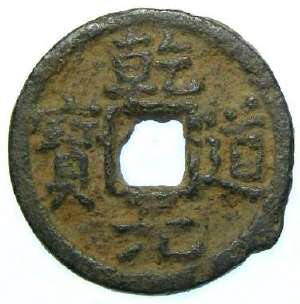 ORTHODOX SCRIPT |
T'UNG MINT
Hartill 17.150, iron 2 cash,"CH'IEN-TAO YUAN-PAO", mint mark at the bottom, no date mark. Average (1 specimen) 26.0 mm, 4.69 grams.
VF $95.00Reign title: SHUN HSI, AD 1174-1189
NO MINT MARK
S-725 variety, bronze 1 cash, "SHUN-HSI YUAN-PAO", Reverse: crescent and two dots at bottom.
gF $8.50S-730, bronze 2 cash, "SHUN-HSI YUAN-PAO", no year mark.
gF $7.00MINT AND DATE MARKED COINS
Sometime in the first 6 years of Shun-hsi, the practice of putting Mint marks on the reverse was introduced for Iron but not bronze coins. The 7th year saw the introduction of regal dates on the reverse of almost all coins, bronze and iron. Schjoth (page 34) states the dates were added to stop illicit casting, and were successful in doing so. There has to be more to this than meets the eye. We see no reason why the practice would have affected counterfeiting by the general population, as they would have simply made coins bearing the date and mint marks. Since the counterfeiting stopped, we can assume the problem was not with the general public. On the other hand, when mint and date marks are combined, it makes it possible to identify the mint official responsible for any given issue. This would be a great deterrent to the casting of sub-standard coins by official mints.
The next question that is raised is why were mint marks not added to bronze coins. The obvious answer would appear to be that there was only one mint casting bronze coins, but is not certain. The bronze coins of this reign title are fairly common, and seem to exist in numbers far to large for the production of a single mint. Another possible answer is that bronze coins, being non-feduciary in nature, were not as easy a target for sub-standard casting and as tight of controls were not deemed necessary. This is an area that needs more research.
S-735, bronze 2 cash, "SHUN-HSI YUAN-PAO", Year-11.
F $6.00 gVF $12.00S-738, bronze 2 cash, "SHUN-HSI YUAN-PAO", Year-14.
aVF/F $7.00CH'UN MINT
S-751, iron 2 cash "SHUN-HSI YUAN-PAO", Year-14.
gF $45.00T'UNG MINT
NOT LISTED, like S-726 but iron 2 cash, "SHUN-HSI YUAN-PAO", no year mark, Reverse: mint mark at the top.
gF $40.00NOT LISTED, iron 2 cash, "SHUN-HSI YUAN-PAO", Year-14. Reverse: mint mark at the top.
aVF $65.00NOT LISTED, iron 2 cash, "SHUN-HSI YUAN-PAO",
Year-15 (to left), Reverse: mint mark to the right and date to the left (unusual).
Emperor KUANG TSUNG
AD 1190-1194
Reign title: SHAO-HSI, AD 1190-1194
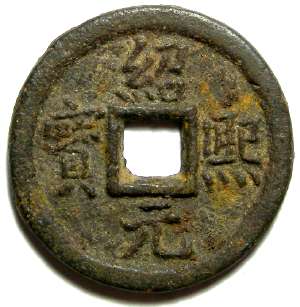 S-773 |
CH'UN MINT
S-772, iron 1 cash, "SHAO-HSI T'UNG-PAO", Year-5.
VF/F $39.50NOT LISTED, iron 2 cash, "SHAO-HSI T'UNG-PAO", Year-3 to left, mint mark to the right, orthodox script.
VF/F $75.00T'UNG MINT
NOT LISTED, iron 2 cash, "SHAO-HSI T'UNG-PAO", mint mark at the top. There is no year mark but it may have been removed.
VF $10.00NOT LISTED, iron 2 cash, "SHAO-HSI T'UNG-PAO", Year-5.
VF/G $40.00HAN MINT
It appears that the Han mint (in Hupei province) was opened in the first year of Shao-hsi (AD 1190). While Schjoth did not have one, we have owned an example of Han year-1.
Emperor NING TSUNG
AD 1195-1224
The coinage of Ning Tsung is by far the most interesting and diversified of the Sung Dynasties, and possibly any Chinese Emperor. During as 29 year reign he used 5 reign titles, issued prolifically in both bronze and iron, and made extensive use of mint and date marks. Schjoth lists about 180 different examples, which is by no means a complete listing of what must have existed.
This is the part of this site that we will be working on next.
Reign title: CH'ING-YUAN, AD 1195-1200
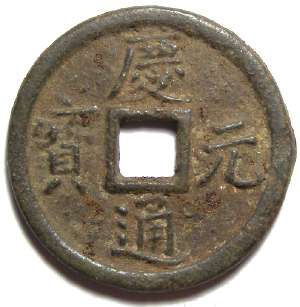 |
Schjoth (page 36) says "In the 3rd year of Ch'ing-yuan (A.D. 1197) the Shen-ch'uan mint cast 'value three' coins from the accumulated copper utensils obtained". The coins referred to appear to be the larger copper issues, S-800-802, which do not bear mint marks. Schjoth has specimens date years 4, 5 and 6. This appears to be the same mint that cast a set of unusual iron coins (S-854-856) which appear to be dated years 1, 2 and 3. This is the first evidence we have found that during a single reign title a mint cast both non-mint-marked copper coins and mint marked iron coins, but it should be noted that there is no overlap in the date marks, so there is still no evidence of both being cast at one mint at the same time.
CH'UN MINT
S-806, iron 1 cash, "CH'ING-YUAN T'UNG-PAO", Year-5.
F $35.00S-806, iron 1 cash, "CH'ING-YUAN T'UNG-PAO", Year-5.
gF $40.00NOT LISTED, iron 1 cash, "CH'ING-YUAN T'UNG-PAO", Year-6.
VF/F $40.00S-814, iron 2 cash, "CH'ING-YUAN T'UNG-PAO", Year-3.
VF/VG $35.00S-816, iron 2 cash, "CH'ING-YUAN T'UNG-PAO", Year-6.
F $40.00HAN MINT
NOT LISTED iron 1 cash, "CH'ING-YUAN T'UNG-PAO", Year-4.
aF $29.50T'UNG MINT
NOT LISTED, iron 1 cash, "CH'ING-YUAN T'UNG-PAO", Year-5.
VG/F $25.00S-812, iron 2 cash, "CH'ING-YUAN T'UNG-PAO", Year-5.
VG-F $29.50CHUAN MINT
Schjoth 824-828 represent an unusual series of iron coins. The meaning of Chuan mint mark is fairly clear but there are other characters of uncertain meaning. S-824 has a "5" to the left which may or may not be a date mark. S-825 as two marks, 7 at right and 30 at left (formed by a combined 3 and 10), neither of which can be a date mark as this title only lasted six years. S-826 has a "6" at the left and "3" at the right. Either one, but not both, could be date marks but S-825 and S-827 suggest this series is not dated. S-827 has a "9" at the top beside "Chuan", which cannot be a date mark. S-828 has a "6" at the top beside "Chuan" and the same 7 and 30 marks seen on S-826, at the bottom. The meaning of these is unclear, but it should be noted that a similar series (S-854-856), also of the chuan mint, have similar marks, as does S-873. It appears that the Chuan mint used a different system than other mints. At 33 mm, these coins are larger than the normal series (although the same as S-829-834 discussed next). It is possible they are some type of emergency issues but we are as yet unable to provide an explanation of them.
IRON COINS WITHOUT MINTMARKS
Schjoth 829-833 are another odd series of iron coin. Since they are also 33 mm, they are probably related to S-824-828. Schjoth lists these as of unclear meaning, but we have a theory about them. All have the crescent with 2 dots at the top, which Schjoth suggests means value 3 cash, which we will accept for the moment (but are uncertain about). The marks at the bottom 1-5 (or 15), 2-5 (or 25), 3-5 (or 35), 4-5 (or 45) and 6-5 (or 65). Note there is no 5-5 but there is a type with no numbers on the reverse that may occupy that position in the series (the Chinese of this period did not like to repeat characters on coins, as can be seen from some unusual reign titles). Also note we have not yet documented any year-5 iron coins from other mints. It is possible that in year 5 an experiment was tried whereby the 1, 2, 3, 4, blank=5, and 6 indicate the mints of issue. Other explanations are possible, including that the numbers indicate furnaces (workshops) with one central mint. It has also been suggested that these are mould series marks, but as non-reusable sand molds were probably used, and every mould was different, mold numbers would be pointless.
At first glance, S-823 to 833 all appear to be value 3 cash. Some bare the crescent with 3 dots mark which may indicate value 3. There seem to be two weight standards in use. S-823-829 are all in the 11 to 13 grams range while 830 to 833 are at a 9 to 10 gram range. The 9 to 10 grams coins have no mint marks but the crescent with 2 dots mark at the top, with double digit mark at the bottom composed a 5 on the right and A 1, 2, 3 or 4 on the left. This confused the issue slightly and needs to be given more consideration. The heavier coins, S-823-829 are years 5, 6, 7 and 8 as well as one with no date mark.
Reign title: CHIA-T'AI, AD 1201-1204
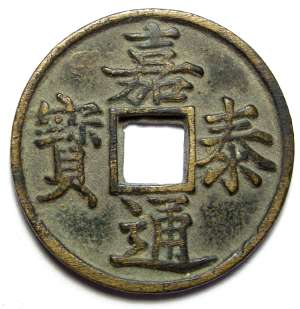 ORTHODOX SCRIPT |
S-843. Bronze 3 cash. Obverse : CHAI T'AI TUNG PAO (read clockwise from the top). Reverse : blank. Average (1 specimen) 34.6 mm, 10.54 grams.
S-852 is shown in Schjoth's illustration as a blank reverse, but in the text he notes it is a blurred reverse, indication something was there.
S-853 is an unusual coin. It has the "LI" mint mark at the top and the numbers 9 and 6 (or 96) at the bottom. Neither digit can be a date. This seems to be related to S-829-833 above although it is not over-sized as they were. We do not yet have an explanation this.
S-854-856 are also unusual. On the top of the reverses they all have the Chuan mint mark with the digits 1, 2 and 3 beside. This appear to be year marks. At the bottom they each have another double digit mark, 8-3 (or 83), 93 (or 93) and 10-4 (or 40). As yet we do not have an explanation for them.
Reign title: K'AI-HSI, AD 1205-1207
BRONZE ISSUES
Under the K'ai-Hsi title bronze coins were issued in both the 1 and 2 cash denomination, with date marks but not mint marks. The 1 cash average (3 specimens) 3.44 grams, 24 mm. The 2 cash average (3 specimens) 5.73 grams, 28 mm.
S-857. Bronze 1 cash. Obverse : "K'ai-Hsi T'ung-pao". Reverse : "Yuan" for year-1 (AD 1205). Value not yet recorded.
S-858. Bronze 1 cash. Obverse : "K'ai-Hsi T'ung-pao". Reverse : Year mark for year-2 (AD 1206).
F $4.00 VF $6.50S-859. Bronze 1 cash. Obverse : "K'ai-Hsi T'ung-pao". Reverse : Year mark for year-3 (AD 1207). Value not yet recorded.
S-860. Bronze 2 cash. Obverse : "K'ai-Hsi T'ung-pao". Reverse : "Yuan" for year-1 (AD 1205). Value not yet recorded.
S-861. Bronze 2 cash. Obverse : "K'ai-Hsi T'ung-pao". Reverse : Year mark for year-2 (AD 1206). Value not yet recorded.
S-862. Bronze 2 cash. Obverse : "K'ai-Hsi T'ung-pao". Reverse : Year mark for year-3 (AD 1207). Value not yet recorded.
IRON ISSUES
The iron issues of the K'ai-hsi period are for the most part fairly standard. There are issues for year 1, 2 and 3 from each of the three principle mints of T'ung, Han and Ch'un, but only in the two cash denomination.
S-863 to 871. Iron 3 cash. Obverse : "K'ai-Hsi T'ung-pao". Reverse : date and mint mark. These will be written up at some future date.
Schjoth listed the following three issues that do not fit the standard pattern but appear to be of a 3 cash denomination.
S-872. Iron 3 cash. Obverse : "K'ai-Hsi T'ung-pao". Reverse : blank. Average (1 specimen) 10.93 grams. The blank reverse on this specimen seems rather odd and does not fit with other issues of this period. I suspect Schjoth's specimen was simply too corroded and what ever was on the reverse was not visible. Value not yet determined.
S-873. Iron 3 cash. Obverse : "K'ai-Hsi T'ung-pao". Reverse : "SAN CH'UAN SSU ERH" (thee Ch'uan twenty four). It seem likely that 3 Ch'uan means third year at Ch'uan mint, but the meaning of the 24 is as yet unclear (Schjoth speculates it is a mold number that seem unlikely to me). Average (1 specimen) 11.58 grams. value not yet determined.
S-874. Iron 3 cash. Obverse : "K'ai-Hsi T'ung-pao". Reverse : "LI LIU SHIH" (LI sixty). LI may be the mark for the Shao-Hsing mint in Li-chou. The meaning of the number sixty is as yet uncertain. Average (1 specimen) 9.35 grams.
Reign title: CHIA-TING, AD 1208-1224
S-903-904 iron only unusual in that the Li-chou mint mark is written in full rather than with only the Character for LI.
S-905 iron is unusual as it does not have a mint mark and the date mark is at the top. It is a typical type for an bronze coin. It should be checked to see if it is really iron.
S-934-958 are a complex series of coins that will need a lot of study to sort out. This will have to wait until later.
Emperor LI TSUNG, AD 1225-1264
Not that Schjoth (top of page 40) notes that Li tsung's government was over-burdened with the difficulties of war. This must be considered when interpreting this next series of coins. It might help explain the unusual series S-983-990. Is the stopping iron issues (from S-991 on) related to this war?
Reign title: PAO-CH'ING, AD 1225-1227
To use the Pao-ch'ing reign title on a coin would have required the character for "Pao" to occur twice on the same coin. It had long been established that characters were generally not repeated on the obverse of Chinese coins, so in a tradition stating much earlier, an inscription commemorating the Sung Dynasty was chosen. In this case it was "TA-SUNG YUAN-PAO" which means roughly "coinage of the great Sung dynasty".
Schjoth seems to think that coins with the "Pao-ch'ing" inscriptions were cast in the first few months of this title, but he did not have a specimen and we have never seen one. Since is would have gone against long standing tradition to have cast such coins, we would want to examine any such specimens for authenticity before including them in this listing.
| Bronze 1 cash | 23 mm | 3.45 gr | 2 seen |
| Bronze 2 cash | 29 mm | 6.29 gr | 3 seen |
| Iron 2 cash | 29 mm | 7.74 gr | 2 seen |
| Iron 3 cash | 31 mm | 12.83 gr | 1 seen |
BRONZE COINS
S-959-960, bronze 1 cash. Obverse: "TA-SUNG YUAN-PAO". Reverse: mark indicating year of issue. All years from 1 to 3 been documented (we once had the year 2 that Schjoth was missing).
VF $27.50S-961-963,bronze 2 cash. Obverse: "TA-SUNG YUAN-PAO". Reverse: mark indicating year of issue. Years 2 and 3 have been documented. Schjoth had a year three with a crescent in the bottom right corner. We have not yet determined a value for this type.
IRON COINS
NO MINT MARK
S-965 iron 2 cash. Obverse: "TA-SUNG YUAN-PAO". Reverse: blank. This coin is an anomaly for this period, as blank reverses are not normal on iron coins. Sometimes the reverses are weak on these and if the coin was in poor condition, possibly not legible. This coin should be examined very closely. We have not yet determined a value for this type.
S-966 iron 2 cash. Obverse: "TA-SUNG YUAN-PAO". Reverse: "LI-CHOU HSING-SHIH" (the currency of Li-Chou). Not that these is not date on this type. We have not yet determined a value for this type.
CH'UAN MINT
S-964 iron 3 cash. Obverse: "TA-SUNG YUAN-PAO". Reverse: "CH'UAN SAN" (Ch'uan mint year 3). Only year 3 has been documented but we would expect others to exist. We have not yet determined a value for this type.
Schjoth listed all three of these iron coins as value 3 cash, but both the sizes and the weights clear indicate that two different denominations were intended
Reign title: SHAO-TING, AD 1228-1233
| Bronze 1 cash | 23 mm | 3.37 gr | 7 seen |
| Bronze 2 cash | 29 mm | 6.65 gr | 6 seen |
| Iron 1 cash | 25 mm | 5.89 gr | 1 seen |
BRONZE COINS
S-967-972, 975 bronze 1 cash. Obverse: "SHAO-TING T'UNG PAO". Reverse: mark indicating year of issue. All years from 1 to 6 been documented.
F $5.00 VF $9.00S-973, 974, 976-979 bronze 2 cash. Obverse: "SHAO-TING T'UNG PAO". Reverse: mark indicating year of issue. Only year 1 has been documented. We have not yet determined a value for this type.
Schjoth describes his example #975 as a clipped two cash, but if the diameter within the rims are drawn accurately, we so no reason to believe it was not cast as a one cash.
IRON COINS
CH'I-CHUN MINT
S-980 iron 1 cash. Obverse: "SHAO-TING T'UNG PAO". Reverse: "CH'UN SAN" (Ch'un mint year 3). Only year 3 has been documented but we would expect others to exist. We have not yet determined a value for this type.
Reign title: TUAN-P'ING, AD 1234-1236
This is the last Southern Sung reign title under which iron coins were cast, and for which mint marks were used.
| Bronze 1 cash | 22 mm | 3.76 gr | 1 seen* |
| Bronze 5 cash | 34 mm | 10.64 gr | 1 seen |
| Bronze 10 cash | 40 mm | 26.58 gr | 1 seen |
| Iron 1 cash | 25 mm | 7.19 gr | 1 seen |
| Iron 2 cash | 29 mm | 10.92 gr | 1 seen |
| Iron 5 cash | 35 mm | 11.36 gr | 1 seen |
* One of the two specimens Schjoth had is listed as weighing 5.91 grams, which is so far off the usual standard we have to assume the listing is an error and have only included one of the specimens in the weight calculation. Hopefully we will be able to locate more specimens in the near future.
BRONZE COINAGE
S-981-982, bronze 1 cash. Obverse: "TUAN-P'ING YUAN-PAO". Reverse: mark indicating year of issue. Only year 1 has been documented. We have not yet determined a value for this type.
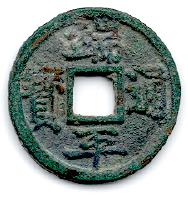 S-983 |
S-983, bronze 5 cash. Obverse: "TUAN-P'ING YUAN-PAO". Reverse: blank. A recent specimen we handled was 35.5 mm, 10.4 grams. This is a fairly common type.
F $15.00 VF $25.00S-984, bronze 10 cash. Obverse: "TUAN-P'ING YUAN-PAO". Reverse: "LI CHE SHIH" (Li-chou value 10). We have not yet determined a value for this type.
Schjoth (page 39) suggest this is a bronze trial casting for an iron type. As it bears a mint mark this is possible, but as of yet we have not seen any evidence for iron examples having been issued. The presence of bronze value 10 cash coins in the next reign title, as well as under Chia-ting (AD 1208-1224), suggest it was more likely was intended as a bronze 10 cash. The mint mark makes it an anomaly amoung bronze coins of this period, but many of the coins of this reign title are unusual types.
IRON COINAGE
The iron coins of this reign are unusual in that none of the specimens we have so far documented bear dates, and only some of them bear mint marks. This shows some type of coinage reform was underway, which seems to have resulted in a total stop to the issue of iron coins by the end of this period.
CHIUNG MINT
S-985, iron 5 cash. Obverse: "TUAN-P'ING YUAN-PAO". Reverse: "CHIUNG WU" (Chiung mint value 5). We have not yet determined a value for type.
TING-CHOU MINT
S-986, iron 5 cash. Obverse: "TUAN-P'ING YUAN-PAO". Reverse: "TING-WU PEI-SHANG" (value five of Ting-chou, upper north). We have not yet determined a value for this type.
HUI (MIN) MINT
S-988, iron 5 cash. Obverse: TUAN-P'ING T'UNG-PAO". Reverse: "HUI-WU HSI-SHANG" (value five of Hui Mint, upper western). We have not yet determined a value for this type.
Schjoth illustrates both S-986 and 988 as being without rims, but makes no comment about this. We assume that his specimen was just in very poor condition, which is not unusual for iron coins. Both types have reverse inscriptions which are not yet understood. Like some other South Sung Iron coins of this general period, there is a reference to a geographic direction and a rank with these as upper, S-1000 as second. We are not sure if his translation is correct and wonder if upper could also mean something like main, first or primary, in which case we might take these to mean that the mint mark lists the governmental office in charge and that the secondary mark referes either to a specific mint, or a workshop within a mint. This needs more research and the help of a better translator.
NO MINT MARKS
S-989, iron 1 cash. Obverse: "TUAN-P'ING T'UNG-PAO". Reverse: blank. We have not yet determined a value for this type yet.
Schjoth refers to this as a 2 cash but at 25 mm it is far more likely to have been intended as a 1 cash. At 7.19 grams it a little heavy, but all the evidence indicates that size is far more important then weight in determining denomination (see our discussion of size and weights under the Northern Sung dynasty) and it is not unusual for iron coins to be significantly heavier than bronze coins of the same size. (the same applies to the 2 cash below).
S-990, iron 2 cash. Obverse: "TUAN-P'ING T'UNG-PAO". Reverse: blank. Schjoth refers to this as a 3 cash but at 29 mm it is far more likely to have been intended as a 2 cash. We have not yet determined a value for this type yet.
S-987, iron 5 cash. Obverse: "TUAN-P'ING YUAN-PAO". Reverse: blank. We have not yet determined a value for this type yet.
Reign title: CHIA HSI, AD 1237-1240
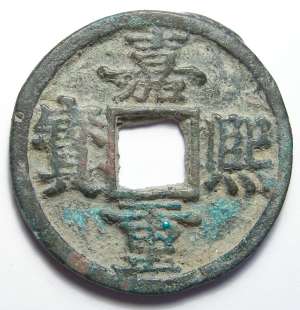 |
| Bronze 1 cash | 22 mm | 3.58gr | 3 seen |
| Bronze 2 cash | 27 mm | 6.66 gr | 5 seen |
| Bronze 5 cash | 37 mm | 15.75 gr | 3 seen |
| Bronze 10 cash | 48 mm | 40.04 gr | 1 seen |
S-991-993, bronze 1 cash. Obverse: "CHIA-HSI T'UNG-PAO". Reverse: mark indicating year of issue. All years from 1 to 4 have been documented.
VG $3.50 F $5.00S-994-998, bronze 2 cash. Obverse: "CHIA-HSI T'UNG-PAO". Reverse: mark indicating year of issue. All years from 1 to 4 have been documented, plus a year 2 with a crescent at the top. We have not yet determined a value for these.
S-999, bronze 5 cash. Obverse: "CHIA-HSI CHUNG-PAO". Reverse: blank. We recently had a two specimens, both of 37 mm. The average weight of thee specimens was 15.75 grams. The specimens we have had were well cast with bold deep characters.
F $50.00 VF $75.00Schjoth considered these to be value 3 cash, but at 35-37 mm and about 16 grams, it is much larger than the 31-32 mm and 10.74 grams one would expect (based on a average 3.58 for the one cash) but only slightly below the range one would expect for a value 5 cash. The next issue, S-1000, is clearly intended to be a value 10 cash, and at 40.0 grams is just at the upper limit for a full weight 10 cash, we feel it is safe to assume S-999 was intended as a non-fiduciary 5 cash.
S-1000, bronze 10 cash. Obverse: "CHIA-HSI T'UNG-PAO". Reverse: denomination mark for 10 at the top with "HSI ERH" at the bottom. We have not yet determined a value for this type.
As the weight of this issue is consistent with a 10 cash, we so no reason not to believe that the "10" at the top of this coin is not a mark of denomination. The 'HSI ERH" at the bottom is more of a mystery. Schjoth translates it to "Western second (series)", the meaning of this is as yet uncertain. We can speculate that this is a type of mintmark. Earlier we mentioned that some of the "mint marks" are in fact the names of governmental admistrative districts, rather than specific mints, and that it is possible that several mints may have opperated withing each of these areas. It is possible that the term "Western second series" is a designation of a specific mint within one of these areas.
Reign title: SHUN-YU, AD 1241-1252
| Bronze 1 cash | 23 mm | 3.09 gr | 10 seen |
| Bronze 2 cash | 28 mm | 5.87 gr | 10 seen |
| Bronze 100 cash | 37 mm | 14.22 gr | 1 seen |
| Bronze 100 cash | 50 mm | 28.41 gr | 1 seen |
S-1001-1010, bronze 1 cash. Obverse: "SHUN-YU YUAN-PAO". Reverse: mark indicating year of issue. All years from 1 to 12 have been documented
VG $3.50 F $5.00 VF $9.00S-1011-1021, bronze 2 cash. Obverse: "SHUN-YU YUAN-PAO". Reverse: mark indicating year of issue. Years 1, 2, 3, 4, 6, 7, 8, 9, 10, 11 and 12 have been documented. We have not yet determined a value for these.
S-1022-1023, bronze 100 cash. Obverse: "SHUN-YU YUAN-PAO". Reverse: mark indicating the denomination. These do not have year marks. We have had one example of the smaller version.
gF 195.00.S-1022 is half the weight of S-1023. It may be significant that that S-1022 is about the same standard as S-999 (probably a 5 cash), and S-1023 is about the same as S-1000 (10 cash), both of the previous reign title. The question is why would such fiduciary issues be necessary. A study of the history of this reign title might suggest something. The most likely cause would be an economic crisis brought on by war. It is likely the two sizes date to different parts of the reign, but without date marks we may never know for sure.
Reign title: PAO-YU, AD 1253-1258
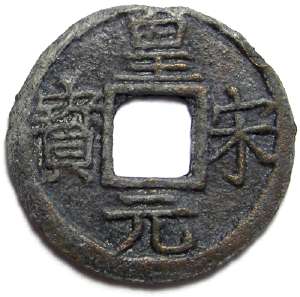 |
Coins of this reign title us the inscription "HUANG-SUNG YUAN-PAO" which means "the currency of the Imperial Sung". This was done was using Pao-yu would require repeating the character for Pao, which was considered to be incorrect. A similar situation occurs on some coins of the Northern Sung period.
| Bronze 1 cash | 23.0 mm | 3.00 gr | 7 seen |
| Bronze 2 cash | 29.1 mm | 5.54 gr | 6 seen |
S-1024-1029, bronze 1 cash. Obverse: "HUANG-SUNG YUAN-PAO". Reverse: mark indicating year of issue. All years 1 to 6 have been documented.
F $4.50S-1030-1035, bronze 2 cash. Obverse: "HUANG-SUNG YUAN-PAO". Reverse: mark indicating year of issue. All years 1 to 6 have been documented.
F $6.00 VF $9.00Reign title: K'AI-CHING, AD 1259
| Bronze 1 cash | 23 mm | 3.13 gr | 1 seen |
| Bronze 2 cash | 27 mm | 6.97 gr | 1 seen |
S-1036, bronze 1 cash. Obverse: "K'AI-CH'ING T'UAN-PAO". Reverse: mark for Year-1. We have not yet determined a value for these.
S-1037, bronze 2 cash. Obverse: "K'AI-CH'ING T'UAN-PAO". Reverse: mark for Year-1. We have not yet determined a value for these.
Reign title: CHING-TING, AD 1260-1264
| Bronze 1 cash | 23 mm | 3.06 gr | 4 seen |
| Bronze 2 cash | 28 mm | 6.19 gr | 7 seen |
S-1038-1041, bronze 1 cash. Obverse: "CHING-TING YUAN-PAO". Reverse: mark indicating year of issue. Years -1, 2, 3 and 4 are known.
VG $3.50 F $6.00 VF $8.50S-1042-1048, bronze 2 cash. Obverse: "CHING-TING YUAN-PAO". Reverse: mark indicating year of issue. All years from 1 to 5 have been documented. As well, Schjoth has one example of year 4 with a crescent at the right. We have not yet determined a value for these.
Emperor TU TSUNG
AD 1265-1274
Tu Tsung was the last emperor of the Sung dynasty, ruling for 10 years with only one reign title.
Reign title: HSIEN-SHUN, AD 1265-1274
| Bronze 1 cash | 22 mm | 3.11 gr | 6 seen |
| Bronze 2 cash | 28 mm | 4.86 | 9 seen |
S-1049-1054, bronze 1 cash. Obverse: "HSIEN-SHUN YUAN-PAO". Reverse: mark indicating year of issue. Years -1, 2, 3, 5, 6 and 8 are known. We have not yet determined a value for these.
S-1055-1063, bronze 2 cash. Obverse: "HSIEN-SHUN YUAN-PAO". Reverse: mark indicating year of issue. All years from 1 to 8 have been documented. As well, Schjoth has one example of year 4 with a crescent at the right. We have not yet determined a value for these.
The current data suggest that there was a weight reduction in the 2 cash, from about 6.2 to 4.9 grams. We need to see more specimens to be sure this is really the case, but if it is, it may have been a measure take as the Mongols were closing in.
BRONZE CURRENCY BARS
Schjoth lists these as talley sticks, which we take to mean they were used to keep track of accounts. The inscriptions state they were "current" which clearly indicated they circulated and were therefore money. Similar items, but of bamboo, were made and circulated at the end of the Ching Dynasty and early in the Republic.
It is not clear when, or by whom, these were issued, but Schjoth (page 40) indicates that Lin-an-fu (now Hangchow) only had that name from AD 1129 until the end of the Sung period. If this is correct, then these must have been cast during the Southern Sung Dynasty.
S-1064, bronze 500 cash currency bar. Obverse: "LIN-AN-FU HSING-YUNG" (current in Lin-an Prefecture". Reverse: "CHU WU PAI WEN SHENG" (Value five hundred cash with a reduction). 22x70 mm, 26.14 grams. No value yet determined.
S-1064a, bronze currency bar. Obverse: "LIN-AN-FU HSING-YUNG" (current in Lin-an Prefecture". Reverse: "CHU WU PAI WEN SHENG" (Value two hundred cash with a reduction). 20x65 mm, 18.80 grams. No value yet determined.
The statement they are valued with a reduction is something I do not yet understand. I have seen a number of these for sale in recent years and in my opinion none that I physically examined were genuine.
The Yuan, Ming and small Dynasties AD 960-1644.
Copyright © 1997 - 2025 R & T Enterprises Ltd.